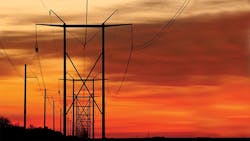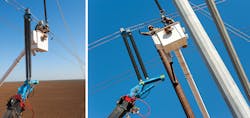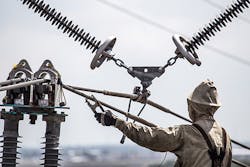Energized Rebuild
The energized reconductor project in the Lower Rio Grande Valley (LRGV) that finished in November 2015 is a landmark achievement for American Electric Power (AEP) and the utility industry. By capitalizing on innovative technologies from across the industry, AEP solved an immediate need to provide reliable electricity to its customers in the LRGV and simultaneously addressed future load growth. This challenge was met by Quanta Energized Services (QES), an entity of Quanta Services, which is the recognized industry leader for live-line work. The forward-thinking partnership enabled the entire 240-mile (386-km) reconductoring job to be completed while in an energized state and eight months ahead of schedule.
For many years, the LRGV was primarily served by two 345-kV transmission lines that originated in Corpus Christi, Texas, U.S. — 120 miles (193 km) to the north. Extraordinary weather events in 2010 and 2011 demonstrated that these aging resources had to be upgraded to provide south Texas with reliable service. Adding urgency, these parallel lines run precariously near the Texas Gulf Coast, which exposes them to hurricanes, storm surges and corrosive salt spray.
Steady Load Growth
Summer highs in the LRGV routinely hit triple digits. The high temperatures in conjunction with a population growth of 30% from 2000 to 2010 resulted in AEP’s peak electric demand more than doubling from 1000 MW in the summer of 2000 to a summer record peak demand of 2220 MW in 2010.
In February 2011, south Texas experienced record winter temperatures, which dropped as low as 20°F (-7°C). For a region accustomed to average February temperatures in the mid-60s, these low temperatures were crippling. Panicked residents flooded the stores in search of portable heaters. This immediate demand for electricity in conjunction with downed generation for prescheduled maintenance overloaded the electric transmission system and led to rolling blackouts.
While an increase in load over a decade is to be expected, a 514-MW jump from the previous summer record of 2220 MW to 2734 MW during the 2011 winter storm was outside all modeled projections. Furthermore, projected growth in the LRGV showed 2016 summer peak load was expected to reach 2800 MW and a forecasted summer 2020 peak load of more than 3000 MW.
AEP needed a plan to immediately relieve circuits most affected by the short-term seasonal spikes plus meet expected load increases for 2016, 2020 and beyond. AEP provided the Electric Reliability Council of Texas (ERCOT) with a solution that could meet the pressing reliability demands while safely maintaining the aggressive schedule. ERCOT was presented with several traditional “cold” construction options, running the gamut from temporary upgrades to complete overhauls.
However, as AEP looked into permitting, rights-of-way acquisition and various customer disruptions, it became apparent these variables had a real chance of interrupting or adding unforeseen costs to the project. The biggest area of concern was ERCOT could only grant construction outages in the spring and summer months, if at all. And if an outage could be granted, ERCOT required the lines be back in service within hours whenever system anomalies warranted.
Taking these limitations into account, AEP determined a traditional construction solution would only delay an already time-sensitive project and, therefore, could not be counted on as a reliable option to meet the 2016 in-service date.
Partnering on a Progressive Option
AEP approached QES to discuss its live-line planning capabilities; North Houston Pole Line, a Quanta Services entity, about its construction expertise; and cable manufacturer CTC Global for its advanced aluminum conductor composite core (ACCC) conductor. A plan emerged to reconductor both lines, all 240 miles, in an energized state. While smaller energized projects had been completed successfully in the past, no utility had attempted an energized reconductor project of this size and length. Nevertheless, in early spring 2011, AEP’s plan to perform the energized reconductor of the existing 345-kV transmission lines was approved by the regional planning group at ERCOT.
A year before the first lineman hit the right-of-way, QES technical advisors went about developing precise, project-specific work procedures with calculated man-hours, sequencing, schedules and anticipated resources. A unique aspect of these one-of-a-kind work procedures — the ability to adapt to job irregularities — proved its worth early in the project.
The bundled conductor was in a vertical rather than the traditional horizontal configuration. To most efficiently tackle this issue, the team needed to adapt both the equipment and the procedures to install the conductor. This first adaptation proved to be a calling card for the entire project.
As the project progressed, lessons learned on the job refined and revised work procedures, and doing so bolstered safety and productivity, allowing the project to finish eight months ahead of schedule and many millions of dollars under budget.
State-of-the-Art Technologies
The collaborative AEP-QES partnership led to the application of several innovative technologies that accelerated the work schedule and ensured the line upgrade stayed on schedule for the required in-service date.
Quanta Services’ barehand methods for energized work and proprietary LineMaster Robotic Arm made it possible for all 240 miles of 345-kV conductor to be removed and replaced without interrupting the flow of electricity. Attached to a boom on a ground-based vehicle, the LineMaster Robotic Arm safely moves and securely holds energized power lines while the conductors, insulators and structures are maintained, replaced or rebuilt. Beside the practical importance of the robotic arm, the barehand work methods were developed by a team that, collectively, has more than 400 years of energized work experience, starting with the first-ever energized reconductor project in 1990.
The use of ACCC to replace the existing conductor boosted line efficiency. Though the same diameter as the original conductor, ACCC is comprised of 28% more aluminum, making it lighter. The extra aluminum doubles the conductivity capacity of the lines and reduces sag as a result of less weight and heat. This meant AEP could replace the old conductor without widening clearances or causing tower modifications or rebuilds. Just as important, given the location of the lines, ACCC is more resistant to corrosion and has the ability to handle future increases in load.
Project Execution
The project called for an aggressive schedule to ensure the line would be upgraded by the required date. The project was divided into five segments between the substations. Doing so resulted in several strategic and financial benefits, including reducing the risk on the entire system serving the LRGV; prioritizing the line sections between the substations, so the completed areas could immediately reap the benefits of the system upgrade; and creating five smaller projects, which increased the efficiency of scheduling materials, equipment and crews as well as minimized project costs.
The barehand work method was instrumental to the success of work performed on the energized conductors. When working barehand, the linemen wore conductive suits and were bonded to the conductor, putting them at the same potential as the energized conductor, which enabled them to physically touch energized conductor and equipment. The robotic arm provided safe, secure and controlled support of the energized conductors, especially for unclipping or clipping operations.
To replace conductors in an energized state, a temporary structure was built at the edge of the right-of-way. Doing so eliminated the need to acquire additional land or permits.
The new conductor was then installed in its permanent position, clipped in and sagged. Load from another phase transferred to this new conductor. The old conductor was de-energized and then reconductored. This procedure was repeated until all three-phases were replaced, without any interruption to the electrical service. This was performed section by section, on average 20 miles to 30 miles (32 km to 48 km). AEP’s plan called for reusing existing structures, thereby minimizing the impact on landowners and negating the timely permits associated with land acquisition and construction.
The energized crews’ ability to perform out-of-scope upgrades, such as replacing damaged V-string insulators and upgrading existing shield wire with optical ground wire fiber, realized other cost savings during construction. Typically, reconductoring work often requires months of planning to get the necessary outages, which could be canceled at any time and result in wasted revenue and man-hours. With crews reconductoring in an energized environment ERCOT took back every scheduled outage, saving project costs.
The Future of Transmission Construction
Completion of the energized reconductor project ensures that communities served by AEP in the LRGV have reliable power today as well as plenty for tomorrow and well into the future. It demonstrates that live-line reconductoring over long distances is a safe and efficient construction method when outage and time constraints make conventional building techniques risky and expensive. It is an achievement that can be repeated by utilities around the globe.
James J. Berger is managing director of transmission projects. His responsibilities include delivering transmission line and station projects for Electric Transmission Texas, AEP’s operating companies, joint ventures and transcos. Berger joined Central Power & Light Co. in Victoria, Texas, in distribution engineering in 1984. Prior to 1992, he held various positions that included responsibilities for standardizing materials used in designing distribution electrical systems, area business office management, developing a corporate-wide work management and outage reporting system, and implementing a mobile computer-based system for use by service personnel.
David Wabnegger serves as president of Quanta Energized Services. He has more than 25 years of lineman experience and has developed 13 separate industry-specific inventions inventions that are either pending, issued or expected to issue in hundreds of countries around the world. As president of QES, he is responsible for leading energized project integration between Quanta Energized Services and the Quanta operating units, as well as providing oversight and expertise to multiple energized education and training programs offered by Quanta.




